The Magic of Pop-Up (or should that be Plop-Up?) with Mini Grey
 The book: it’s portablemagic – an object full of possibilities. With pop-up books there’s thepossibility that the book is a Tardis: bigger on the inside. A world explodesfrom the book. Pop-ups are about movement: the book comes to life in yourhands.
The book: it’s portablemagic – an object full of possibilities. With pop-up books there’s thepossibility that the book is a Tardis: bigger on the inside. A world explodesfrom the book. Pop-ups are about movement: the book comes to life in yourhands.Pop-ups are madepossible by the structure of the book, that central fold that lends itself tomovement and acts as the engine that moves the mechanism: opening and shuttingso that pop-ups can hide away inside.
So, this week(inspired by Garry’s post from April about lift-the-flap books) I thought I’dbring you a quick tour of the history of pop-up, through books I’ve picked upover the years.
The first pop-ups were for grown-ups, todo useful things like show the movements of the planets or the structure of thehuman body.
 De Humani Corporis Fabrica by Vesalius
De Humani Corporis Fabrica by VesaliusIn Andreas Vesalius’s book DeHumani Corporis Fabrica (Onthe Fabric of the Human Body) from 1543, layered pages allow the reader toprobe through the layers of the human body. Now I don’t have this book, but I have seen it! Theimages were woodblock printed, then cut out like fine lacework.
On my bookshelf westart with Lothar Meggendorfer and the first golden age of pop-ups in Victoriantimes. With industrialization, a wealthy middle class was emerging who hadincome to spend on books for children, and all could gather in the evenings tobe entertained by the movable book. Meggendorfer’s moving pictures had an amazinglycomplicated under-structure of tabs and metal pivots.
 Movable horserider by Meggendorfer
Movable horserider by Meggendorfer This is the kind of mechanism of levers and pivots that would have lain beneath the movable piccture.
This is the kind of mechanism of levers and pivots that would have lain beneath the movable piccture.International Circus (by Meggendorfer) isa book that is also a toy and a model.
 My copy of International Circus opened out, each scene pulls down with a parallel box type mechanism.
My copy of International Circus opened out, each scene pulls down with a parallel box type mechanism.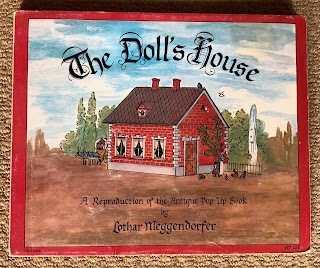
Meggendorfer’s Doll’s House folds outinto a set of rooms you could play with.

That golden age of pop-up wasbrought to a close by the 20th century and the first worldwar: materials for making books became scarce. Then in the late 1920s theDaily Express started publishing the Bookano books.

These were fat volumes withself-erecting pop-up ‘models’. They were made of cheap low-quality paper whichmeant they were affordable, so pop-ups were suddenly available to a massmarket. One Bookano was given to me by John Vernon Lord. It had been given tohim by Raymond Briggs.

It must have been well played with; every single pop-upis broken except one.
 The one unbroken pop-up in Briggs' Christmas present
The one unbroken pop-up in Briggs' Christmas presentBut not broken is the Bookano Story of Jesus – somehow this onestayed safe from young fingers.
Look at this – the last supper, assembled in a panelled room. Judas is skulking off in the background. There's a landscape beyond the back window. Da Vinci would have beenproud.
 In case you're wondering , there are 12 disciples in this pop-up but two of them are at right angles to us so we can only see their Flat Stanley-style edges.
In case you're wondering , there are 12 disciples in this pop-up but two of them are at right angles to us so we can only see their Flat Stanley-style edges.In my Bookano Stories book is a fabulous underwater world complete withcellophane water layer.

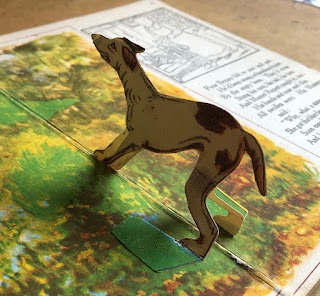
The stand-up models in the Bookano books, like thisdog, remind me of The Tiger Prowls by Seb Braun; there’s something lovely about 3D animalsspringing up on the page.

In Prague I cameacross the work of VojtěchKubašta, who was a former architect and prolific maker of pop-ups from the 1950s.

I love thescary movable cover for his Red Riding Hood. You can watch the whole book here.

He made thousands of works of pop-up. The ones I have are pop-up stand-upmodels, and my favourite is Columbus’s ship.

Probably myultimate favourite and full of endless inspiration for pop-up mechanisms to tryis Jan Pienkowski’s Haunted House.

 Note the pop-up toilet. This one has a black cat inside.
Note the pop-up toilet. This one has a black cat inside.Also in my all-timefavourites is Raymond Briggs’ – Fungus the Bogeyman Plop-Up Book.
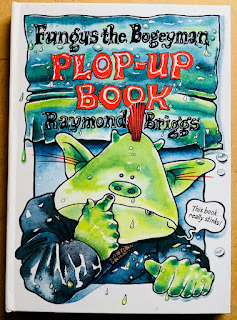
 Here's Fungus about to use the facilities.
Here's Fungus about to use the facilities. Fungus's toilet 'The Leaky' has a sign in it: DO NOT PUT ANYTHING IN HERE UNLESS YOU HAVE EATEN IT FIRST, and it's patented non-flush and guaranteed to rust.
Fungus's toilet 'The Leaky' has a sign in it: DO NOT PUT ANYTHING IN HERE UNLESS YOU HAVE EATEN IT FIRST, and it's patented non-flush and guaranteed to rust.I love thetoilet page, complete with Government Property toilet paper that tells you the addressof the person to complain to about this page (and that there's an entire complaints department dedicated to Fungus the Bogeyman). (For more on the wonderful Raymond Briggs, see Pippa Goodhart's post from last week.)
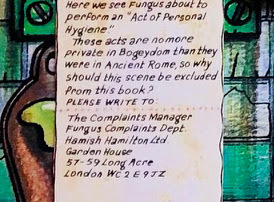
OK, the Pop-up toilet is an obsessionof mine. Here are a couple of pop-up toilets I’ve made.
 From Our Machines are Sick, personal project from long ago
From Our Machines are Sick, personal project from long ago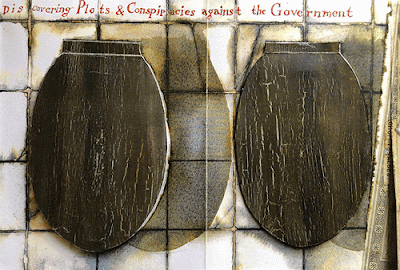 These toilets are for using the contents to discover plots and conspiracies with a bit of stool-reading - from Gulliver's Travels (to Laputa). (personal project from long ago)
These toilets are for using the contents to discover plots and conspiracies with a bit of stool-reading - from Gulliver's Travels (to Laputa). (personal project from long ago)And on, and away from toilets, to the kingof pop-up – Robert Sabuda. My favourite is the Wizard of Oz.

Look at the cityof Oz with its iridescent foil and green glasses to wear.
 The Wizard of Oz by Robert Sabuda
The Wizard of Oz by Robert Sabuda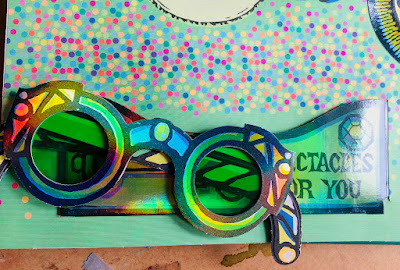
The message in themulticoloured dots is invisible until you put the green glasses on. (In photos you can make it out, but in real life you can't.) There’s also his Alice in Wonderland. Hereis a beautiful V-fold house with a gigantic Alice trapped inside.
 From Alice in Wonderland by Robert Sabuda
From Alice in Wonderland by Robert SabudaThe genius of NickSharrat is in making movable books that play in beautifully simple ways. Here’sthe floating helicopterpus from Octopus Socktopus.
 Octopus Socktopus
Octopus Socktopus
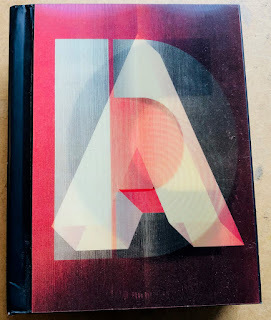 The lenticular cover of ABC3D
The lenticular cover of ABC3DPop-up playtime is not just for children.
ABC3D is a pop-up alphabet of surprises made from purely architectural letters.
Pop-ups can even explainPlate Tectonics. Have a watch here.
In the SensationalBooks Exhibition at the Bodleian Library I came across Creatures of the Deepby Maike Biederstaedt – bringing scientist Ernst Haeckel’s illustrations of underwater flora and fauna to life.

Thereis a Game of thrones pop-up book and a Pop-up Book of Phobias.
 At the dentist in the frankly triggering Pop-Up Book of Phobias
At the dentist in the frankly triggering Pop-Up Book of PhobiasThe Walking DeadPop-up Book – this is an actual horror; zombies attempt to escape the book - lookaway now if you feel fragile.

– and there are even more terrifying pop-ups in this book that I can’t show in afamily-friendly blog like this.
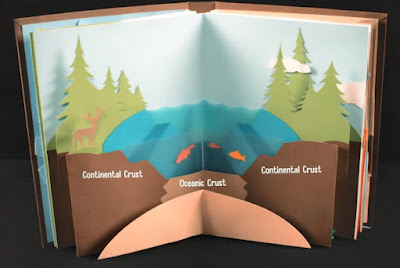
Pop-up involves thereader: the engineer is the puppet-maker, the reader becomes the puppeteer.
But sometimes, lessis more. When my son Herbie was little we acquired the We’re going on a BearHunt pop-up book and you know…the pop-ups felt clunky compared to the pop-up-freeoriginal. A simple flap can often be more effective than a wildly complicated mechanism. The magic of every picture book is to have space for the reader’simagination to get involved.
I’ve only scratchedthe surface of the incredible world of pop-up books in this post. Have you gota favourite? Do let me know!
Bruce Foster, a paper engineer based in the US, commentedabout the process of inventing pop-ups: “The first phase of any project isstrictly playtime,” he said. “I play around a lot, work out these differentmechanisms, putting them all together, experimenting.”
So, to end with, here are some books I’ve found useful for learninghow to make pop-ups, because inventing pop-ups is all about playing with paper.
 Paper Engineering by Mark Hiner.You make your own demonstration models for the mechanisms so it turns into a useful resource for working out what you might need to make - a nice first introduction.
Paper Engineering by Mark Hiner.You make your own demonstration models for the mechanisms so it turns into a useful resource for working out what you might need to make - a nice first introduction. Pop-Up - A Manual by Duncan Birmingham - This is a dense exhaustive guide to just about every paper engineering mechanism. For the die-hard pop-upper.
Pop-Up - A Manual by Duncan Birmingham - This is a dense exhaustive guide to just about every paper engineering mechanism. For the die-hard pop-upper. By the same author - Pop-Up Design and Paper Mechanics is much more user friendly and appealing visually, with a nice set of projects to make at the back.
By the same author - Pop-Up Design and Paper Mechanics is much more user friendly and appealing visually, with a nice set of projects to make at the back. The Elements of Pop-Up by David A. Carter and James Diaz. This is a brilliant resource - it contains little working models for all the mechanisms like a delicious moving menu of pop-up possibilities - being able to see how they move really helps you to choose which mechanism will work for what you want to do.
The Elements of Pop-Up by David A. Carter and James Diaz. This is a brilliant resource - it contains little working models for all the mechanisms like a delicious moving menu of pop-up possibilities - being able to see how they move really helps you to choose which mechanism will work for what you want to do.Still want to see more pop-up books? Watch on Youtube here!
Mini's latest book is The Greatest Show on Earth, published by Puffin.




